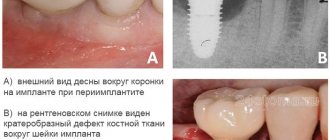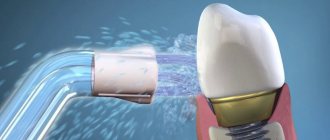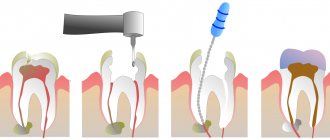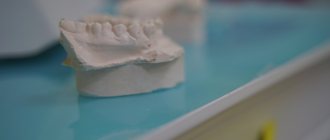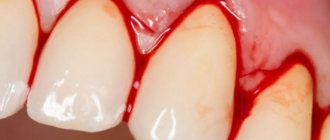Often, caries treatment is surgical, in which case it ends with the installation of a filling. Depending on the material used, the dentist recommends that the patient go without food and drinks for some time. We will tell you in the article how long you can’t eat after caries treatment.
In this article
- Why is it important to follow your dentist's recommendations?
- What determines whether you can or cannot eat after dental treatment?
- A temporary filling has been installed: how much can you eat?
- You've got a light filling - how long can you go without eating?
- Recommendations after installing other fillings
How much can you not eat after having a filling installed?
All patients are interested in whether they can eat after having a filling installed.
You can eat food, but not immediately after the event, but after some time. Experts use various compositions, and each of them has its own hardening time. But first, you need to consider what you can’t eat after installing a filling in order to avoid its premature destruction.
The list of prohibited products includes all solid products, including chips and crackers, viscous - toffee and other products of similar consistency, coloring - coffee and tea, tomatoes, beets and the like. The consumption of hard and viscous products contributes to the destruction of the filling, and the use of coloring products causes a change in the color of the filling material.
Temporary restrictions
The first question that patients ask the doctor after treatment is: how long can you not eat? It all depends on the technology used, and some of them allow you to eat food almost immediately.
But there is one caveat. Even if the top layer has already hardened, the inner layer is subject to deformation. Therefore, there is no need to rush. There are the following general recommendations on time limits (according to the type of material):
- amalgam – 3 hours;
- plastic – from 3 to 5 hours;
- cement - from 2 to 3 hours;
- photocurable composites – can be eaten immediately;
- chemically cured composites – 1 hour;
- temporary fillings except photopolymer ones – from 2 to 3 hours;
- photopolymer temporary fillings – no restrictions.
Using metal as a filling material
Fillings made of metal alloys have high levels of strength and durability; they are made from hypoallergenic materials. In modern dentistry, two types of metal filling material are popular:
- Gold.
- Silver or copper amalgam.
Gold fillings
Gold inlays are the most expensive solution. Their main qualities are strength, durability, and high aesthetic properties. Due to the ability of gold to resist corrosive processes, a filled tooth is not subject to destruction. The precious metal that forms the basis of the filling material determines its high cost. Installing a gold filling is a delicate and responsible job that requires great skill and skill from the doctor.
Is it possible to drink after having a filling installed?
At the appointment, patients always ask whether they can drink tea or other drinks after treatment. In this case, the same recommendations apply as for eating - it all depends on the technology. But there are also additional restrictions. Drinking drinks is not recommended until the anesthesia effect has completely subsided.
This is due to the possibility of injury to the mucous membrane by too hot a liquid, because sensitivity is reduced. It is very difficult to say exactly how long you can drink. In this case, everything depends on the effectiveness of the painkiller, its duration of action, dosage and individual reaction of the body.
Types of fillings and care features
Different fillings have their own characteristics in terms of wearing time, hardening, etc. For example, light fillings harden under the influence of a halogen lamp in a matter of seconds, so you can eat or drink water almost immediately after the procedure. However, you should not remove all restrictions: complete hardening of the filling occurs in two days. Composite fillings are very sensitive to alcohol at first, so you should avoid alcohol and alcohol-containing rinses, as the filling may soften.
After treatment, we recommend that you check with your dentist about the type of filling he placed and after what time you can eat.
Recommendations
Immediately after installation, you must refrain from drinking and eating for the time recommended by the dentist until the final effect of the pain medication. After this period, you should not eat foods that are too hot or too cold, as they may affect the strength properties of the material.
The load should be moderate. It is advisable to try not to chew on this side of the jaw during the day, since the filling may become loose if it does not harden sufficiently.
In addition to traditional questions about food and drink, dental visitors are also interested in additional questions.
Is it possible to drink alcohol
In fact, alcohol does not have any special effect, which means that theoretically it can be consumed. But the point here is completely different. In most cases, filling is performed under anesthesia, and it and alcohol are incompatible. Therefore, experts recommend abstaining from alcohol for at least a day.
The same can be answered to the question “can I drink beer?” After 24 hours, yes, you can. Beer does not contain coloring enzymes and fillings do not change color under its influence.
Is it possible to smoke after installation?
After the filling procedure, you can smoke approximately 2-3 hours later.
. Tobacco smoke does not affect the color of the filling, unless it concerns plastic-based compounds. They are rarely used due to their fragility, but when using such a composition, smoking immediately after the procedure will cause its darkening. Ideally, dentists recommend giving up cigarettes for at least a day, if possible.
Amalgam filling
Amalgam is an alloy of silver or copper with various metals, each of which performs its own function:
- Silver gives strength and antiseptic properties.
- Tin regulates the hardening process.
- Copper increases the strength of the alloy.
- Zinc prevents oxidation.
- Mercury is needed to obtain a plastic, quickly hardening mixture.
Amalgam fillings have both advantages and disadvantages. They are durable and affordable, but have low aesthetic properties (characteristic metallic luster, change in enamel color). These fillings are placed primarily on the back teeth (molars).
Metal fillings have a long hardening period, so dentists recommend that patients refrain from eating for 4-5 hours after the filling procedure. Do not consume foods that can cause metal oxidation. Since the dental alloy is insensitive to moisture, there are no restrictions on fluid intake.
What not to do after installation
The main thing that should not be done after installation is to subject the tooth to increased loads.
. Therefore, gnawing any foods (nuts, seeds, candies, etc.) is highly discouraged. Avoid the use of chewing gum, toffees and other similar confectionery products that tend to stick to teeth.
The consumption of hot and cold foods is limited; this can cause the filling material to break prematurely.
There should be no traumatic impact on the tooth, therefore, if discomfort is felt, you should consult a doctor and not take any action yourself.
Is it possible to brush your teeth
A specialist will definitely advise you on how to brush your teeth after installing a filling. It is advisable to do this only the next day. In some cases, it is recommended to change the paste and brush. It is better to choose a brush of medium softness; it will not injure the injection site. Pastes - on the recommendation of a doctor, but without the inclusion of abrasive components.
Recommendations after installing a light seal
Photopolymer is a new material that instantly hardens under the influence of a solar lamp.
Has high strength characteristics. It is possible to select a shade that best matches the natural one. After installation, such a filling is not visible even on the front teeth.
Care
Caring for teeth with polymer fillings is not particularly difficult:
- they need to be cleaned regularly, with a medium-hard brush and gel toothpastes that do not contain abrasive inclusions;
- Dental floss should be used carefully; if it clings to the edge of the filling, you should immediately contact a specialist to eliminate this defect;
- exclude coloring foods from your diet for at least a week;
- limit the consumption of sweets, including sweet carbonated waters, especially those with dyes;
- For several days after the event, do not load the tooth and limit yourself to solid food.
Is it possible to eat after having a light filling installed?
The photopolymer hardens instantly, but the inner layer does not have sufficient strength for some time. Therefore, a reasonable question arises: “when can you eat?”
Although many doctors allow you to eat food immediately after the event, it is better to refrain from eating for a couple of hours. There is a risk of material deformation.
There is also the possibility of staining, so you need to consider what not to eat.
Foods that can stain the filling are completely excluded from the diet for 7 days. These are any drinks with dyes, including strong tea and coffee. Fruits and berries with a likelihood of such an impact (cherries, sweet cherries, mulberries, blackberries, raspberries, black currants and the like). Vegetables such as carrots and beets. It is worth giving up tomato-based ketchups and sauces, tomatoes themselves in any form, and a number of juices. Dentists recommend following a “white” diet during this period. That is, eat only what cannot stain the filling.
How long does the photopolymerization process take?
Hardening of the polymer surface occurs under the influence of an ultraviolet lamp, creating waves with a length of 450 Nm in the blue spectrum.
Primary polymerization occurs during processing, and the filling acquires final hardness and stabilization of chemical bonds within 24 hours . For this reason, the main restrictions are imposed specifically on the day.
After installing a temporary filling
A temporary filling is necessary for multi-stage treatment, which involves access to the cavity after several days or weeks. Therefore, the strength and aesthetic requirements for such materials are low. But in any case, you must adhere to the specialist’s recommendations, otherwise the filling will fall out, pathogenic microbes will enter the cavity and the procedure will have to be repeated.
After installation of a temporary filling, patients are interested in the ability to eat and drink. These points need to be considered.
Is it possible to drink
If a regular cement filling was used, you can drink after 2-3 hours. If the cavity is closed with photopolymer, immediately after installation is completed. But the point here is not about strength, but more about anesthesia. When exposed to it, sensitivity is minimal, so the patient may not feel the temperature of the drink and injure the mucous membrane. Therefore, you need to drink very carefully, avoid too cold or too hot, and it is better to do this after the painkiller has worn off.
Is it possible to eat
The specialist’s answer depends on the material
. The use of a cement filling involves the same restriction as in drinking: from 2 to 3 hours. With photopolymer, it is absent, but it is not recommended to load the tooth until it has completely hardened, so you will have to abstain from hard foods for at least a day.
Composite
Today, the physical properties of new filling powders have changed. They are successfully used in cases where deep caries has led to the appearance of large abnormal cavities. Composites fully meet modern standards.
- They have excellent cosmetic and practical characteristics.
- They are suitable for reconstruction of frontal, masticatory units.
- They are installed for children and expectant mothers.
- The material hardens directly in the dentist's office. He exposes the pad to a lamp with ultraviolet rays.
- The substance can be easily given the desired shape.
After the light filling, you can drink water and eat after the sensitivity of the receptors returns. Indeed, with numbness of the lips, tongue, and palate, it is easy to cause mechanical and thermal damage to these areas. Therefore, in this situation, it is advisable to eat no earlier than an hour later, especially if a composition with epoxy resins was used. It is better not to consume drinks and foods such as beets, wine, tea, blueberries, coffee for 24 hours. Also, you should not smoke during the day, as nicotine slows down wound healing. If you follow your doctor's recommendations, this will minimize the risk of the pad falling out or becoming deformed.
Is it possible to experience discomfort after treatment?
After the procedure, slight discomfort is present for 14 days - this is normal.
. During this period, it is necessary to eliminate as much as possible the influence of factors that provoke unpleasant sensations - hot and cold foods, sour, spicy and sweet foods. You also need to avoid excessive stress and carry out hygiene procedures with caution.
But if pain occurs after this period has expired, this is a reason to consult a doctor. There are many reasons for this phenomenon, and only a specialist can accurately identify a specific one.
Filling teeth without pain
Nowadays people do not need to be afraid of visiting the dentist, because dental treatment is carried out without pain. High-quality anesthesia is used, and an allergy test is performed first. If the body accepts the drug normally, then the dose is administered in the gum area. After 1-2 minutes the effect appears. A person may notice that the problem area has lost sensation. After this, the doctor can proceed to the procedure itself.
When using anesthesia, a person will not feel pain. You will be able to relax in the dental chair and not worry about anything. This treatment option is the most preferable, because not every patient wants to endure pain.
Some people decide not to use anesthesia. This is because they do not want to administer the medicine or are suffering from an allergic reaction. If the nerve is not affected, the procedure will cause virtually no pain. An experienced specialist will do everything to make the patient feel as comfortable as possible.
What to do if your tooth becomes sensitive after installing a filling?
If after installation the tooth reacts to cold or hot, but the required 2 weeks have already passed, you need to urgently go to the dentist. The exception is recently treated pulpitis. In this case, increased sensitivity persists for up to a month.
The specialist will conduct a diagnosis and determine the cause of this phenomenon. This could be the consequences of poor quality filling installation, inflammation or similar diseases. The most common cause of pain is the occurrence of repeated caries. In this case, the destruction of the enamel continues.
How is dental filling performed?
Installing a filling is a standard procedure that takes place under local anesthesia. First, the person is given an injection in the gum to numb the problem area. After this, doctors proceed to treat the incisor, and the process lasts on average 15-20 minutes.
Main stages:
- The doctor prepares the enamel and drills out the softened dentin using a drill. The patient does not feel pain because he was given an injection.
- The oral cavity is disinfected using an antiseptic solution.
- A special paste with a healing effect is installed, and a gasket is placed for insulation.
- The walls of the oral cavity are dried using air flow.
- The mass is applied layer by layer for further filling.
- The filling is polished to obtain the required occlusion. The crowns should fit tightly.
- Fluoride varnish is applied for protection and distributed over the surface of the filling.
The procedure is simple and standard, so dentists perform it quickly. The patient only needs to listen to the doctor’s advice to avoid problems. If the filling is installed efficiently, it will last for more than one year. The specific period depends on the selected material, quality, and food preferences of the person. Filling is one of the most effective methods of combating caries and pulpitis. Moreover, the procedure is inexpensive and has a minimum number of contraindications.
What causes recurrent caries
Repeated carious lesions of tooth tissue can occur due to non-compliance with technology,
which happens rarely, or
the patient’s failure to comply with the doctor’s recommendations – which happens often
.
Due to the shrinkage of the material, which is caused by increased load on the tooth, microcracks appear between the filling and the tissue. They contain pathogenic bacteria. When they multiply, they form an acidic environment. All this contributes to the occurrence of repeated caries, which is hidden under the filling and is diagnosed only after the active development of the pathology. Therefore, it is very important not to violate the doctor’s recommendations. Also, incorrect actions can cause the filling to fall out.
How to maintain your treatment guarantee
To maintain the guarantee, the patient must strictly follow all recommendations: do not overload the tooth, do not use it for other purposes (for example, opening beer bottles, biting off threads), and also regularly see the doctor in accordance with the individual schedule of medical examinations, approximately once every six months. Unfortunately, many patients forget about this, and it is the last point that is the key to maintaining the guarantee for treatment.
You need to visit a doctor 1-2 times a year. During a preventive examination, the dentist will be able to make sure that the filling is in good condition, and that secondary caries does not develop again under it.
Service life of the light seal
The average service life of photopolymer fillings is 4-5 years, the period is influenced by the following factors :
- Diet.
- Proper and regular dental care.
- Quality of polymerization.
To maximize the service life of the filling, it is recommended to remove or reduce the amount of flour, sweet and too hard foods, soda and coffee consumed from the diet, and follow the dentist’s recommendations regarding cleaning the oral cavity.
About the service life of light seals:
Is it possible to drink: what do doctors say?
If you prefer a restoration method such as a light filling, then now you know exactly how long you can eat after its installation. What about drinking liquids in the form of water, coffee, tea, etc.? Experts recommend not drinking for at least 30-60 minutes after treatment with photopolymer composite materials. This is again due to the reduced sensitivity of tissues and the likelihood of injury to them, for example, with hot tea. And not because liquids will lead to deterioration of the properties of the material and disruption of its adhesion.
As for the intake of alcoholic beverages, it is better to avoid them on the first day after treatment, especially if the procedures were carried out under anesthesia. Remember that alcohol and anesthesia are not compatible; they can cause a negative reaction in the body, increase blood pressure, increase swelling, provoke bleeding (if a complex intervention or surgery was performed) and increase tissue healing time.
Notice
: Undefined variable: post_id in
/home/c/ch75405/public_html/wp-content/themes/UltraSmile/single-item.php
on line
45 Notice
: Undefined variable: full in
/home/c/ch75405/public_html/wp-content /themes/UltraSmile/single-item.php
on line
46
Rate this article:
( 1 ratings, average: 5.00 out of 5)
dental fillings
[1] Bodrova A.A. Achievements of scientific and technological progress in the development of dental filling materials. // Bulletin of medical Internet conferences. – 2014.
